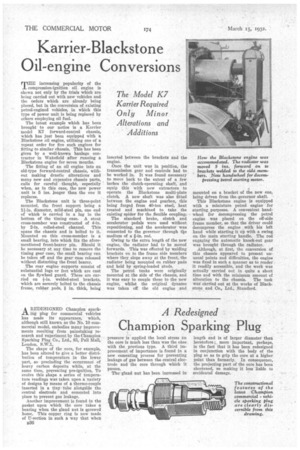Kamer-Blackstone Oil-engine Conversions
Page 54

If you've noticed an error in this article please click here to report it so we can fix it.
The Model K7 Karrier Required Only Minor Alterations and Additions
ninE increasing popularity of the k compression-ignition oil engine is shown not only by the trials which are being carried out with new vehicles and the orders which are already being Placed, but in the conversion of existing petrol-engined vehicles, in which this type of power unit is being replaced by others employing oil fuel.
The latest example which has been brought to our notice is a Karrier model K7 forward-control chassis, which has just been equipped with a Blackstone oil engine, utilizing one of a repeat order for five such engines for fitting to similar chassis. This has been given by a well-known haulage contractor in Wakefield after running a Blackstone engine for seven months.
The fitting of an oil engine into an old-type forward-control chassis, without making drastic alterations and many new and expensive chassis parts, calls for careful thought, especially when, as in this case, the new power unit is 5 ins, longer than the one it replaces.
The Blackstone unit is three-point mounted, the front support being a 14-in. diameter, mild-steel pin, one end of which is carried in a lug in the bottom of the timing case. A stout cross-member was constructed of 4-in. by 2-in, rolled-steel channel. This spans the chassis and is bolted to it. Mounted on this cross-member is a small hearing, into which fits the aforementioned front-bearer pin. Should it be necessary at any time to remove the timing gear case, the small bearing can be taken off and the gear case released without disturbing the front bearer.
• The rear engine supports consist of substantial lugs or feet which are cast on the flywheel guard. These are car ried on welded-steel brackets, which are securely bolted to the chassis frame, rubber pads, in. thick, being inserted between the brackets and the engine.
Once the unit was in position, the transmission gear and controls had to be worked in. It was found necessary to move back to the extent of a few inches the clutch-operating shaft, and equip this with new extractors to operate the Blackstone multi-plate clutch. A new shaft was also fitted between the engine and gearbox, this being forged from 40-ton steel, heat treated and machined to take the existing spider for the flexible coupling.
The standard brake, clutch and accelerator pedals were used without repositioning, and the accelerator was connected to the governor through t4e medium of a ft-in, rod.
Owing to the extra length of the new engine, the radiator had to be moved forwards. This was effected by welding brackets on to the frame side members where they slope away at the front, the radiator being mounted on rubber pads and held by spring-loaded studs.
The petrol tanks were originally mounted at the side of the chassis, and it was easy to couple these to the new engine, whilst the original dynamo was taken off the old engine and mounted on a bracket of the new one, being driven from the governor shaft.
This Blackstone engine is equipped with a miniature petrol engine for starting purposes. A convenient handwheel for decompressing the petrol engine was placed on the off-side frame member, so that the driver could decompress the engine with his left hand while starting it up with a swing on the main starting handle. The rod engaging the automatic knock-out gear was brought through the radiator.
Although, at first, the conversion of this chassis appeared to present unusual points and difficulties, the engine was fixed in such a manner as to render it readily accessible, and the work was actually carried out in quite a short time and with the minimum amount of
alteration to the chassis. The task was carried out at the works of -Blackstone and Co., Ltd., Stamford.




































































































